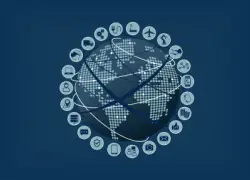
Ever wondered how much data is generated when you log on to the internet for checking the latest update your friend has done on Facebook? Trillions of bytes are transferred back and forth from your IP address. In addition, there are quadrillion like us on the globe having an IP address. Not to forget, we may have multiple of IP addresses if we are using different devices to access the internet. A layer up, how do we solve the ever-growing problem of multiple IP addresses especially when Internet of Things (IoT) appears? A big question because we all want to use IoT-enabled devices that would make use of the internet for its functioning to update Facebook status or to simply understand the statistics of our morning workout. Let us dig deeper and understand how IPv6 can truly level up for IoT.
- What is IPv6?– IPv6 has been around for more than 20 years now, it is not a new invention that is doing wonders, it is a tried and tested method for decades now. Developed by the Internet Engineering Task Force, it replaces the limited IP problem faced by IPv4.
- How is it different from IPv4?– Unique IP addresses are becoming extinct and the need to shift to IPv6 is required at the earliest. It replaces IPv4 from 32 bits to 128 bits per IP address. By doing that, a single user is allocated with 4,000 IP addresses alone. The address space is expanded to 340 undecillion bytes. All IoT-based devices will smoothly fit inside such numbers which promise speedy transfer of data as well.
- Statistics of IPv6– It has been predicted that by 2020 around 50 billion devices would be used having steady internet connection further equating to 6-7 devices per person. Connectivity is not hampered either, smart cities supporting 4G network would have zero problems for IPv6.
Benefits of IPv6 for IoT
Let just say that IPv6 can derive exceptional results from IoT, there are few points which support this claim and they are as follows:
- Security– Due to IPSec, security is highly addressed. Furthermore, IPV6 promotes secure name resolution as well. Technically, the SEND (Secure Neighbor Discovery) protocol can work wonders by providing cryptographic host that can provide confirmation during connection, to which, attacks like ARP (Address Resolution Protocol) and others find it slightly difficult to penetrate through the network. Consider this option preferable if you plan your living in a smart city enabled by IoT devices. However, it all depends on how an IPv6 network is configured; relatively it is more secured than its predecessor- IPv4.
- Address auto-configuration– IoT configuration with the network consumes huge bandwidth and infrastructure cost. To mitigate this problem, IPv6 provides a self-configuration mechanism; the nodes automate their addresses further reducing deployment costs.
- Fully Internet compliant Gateways– Building a proprietary network of smart (IoT) devices or to connect these devices with the outside world through a gateway having complete authentication with IP requirements is easily possible through IPv6 gateways. Being an internet compliant, IPv6 gateways are your savior of the day.
- Standardization– IoT developments (Global IP and Identifier System) can look forward towards the standardization provided by IPv6. Standardization proves to be a real deal breaker for these developments.
- Scalability– IPv6 showcases huge growing potential in the IoT environment. Gartner stated in its report that the current usage is about 4.9 billion connected devices, there is going to be a considerable rise for IPv6 shooting up to 400% by the end of 2020. With these statistics, it is easy to understand the need of IPv6 for IoT-enabled devices. Moreover, TCP/IP is widely used for IoT connectivity; a unique identifier will surely be available in the future as well.
- IP Mobility support– Consider this aspect to be well covered by IPv6. IPv6 will support wireless terminals that consist WAP and GPRS as there are plenty of IP addresses available. IPv6 is a cost efficient architecture providing millions of addresses without the need of NAT, ALGs and Proxies. It also offers push notifications, location-based services and security features as well, an added advantage in the bag for IoT-enabled devices. Furthermore, mobile apps with IPv6 enablement would require additional exposure that would strike the perfect balance between the practicality of the design with the principles of the IoT ecosystem.
Quick facts that enable IoT services through IPv6–
- Connectivity is not hampered; Wi-Fi, 3G and 4G support IPv6.
- IETF has 6LoWPAN enables data transmission of IPv6 packets over IEEE 802.15.4 type of networks.
- Accessing internet through Bluetooth-connected IoT devices is possible as well. IPv6 passes the support test via IPv6/6LoWPAN.
- ZigBee IP enables IPv6 network protocols towards IEEE 802.15.4 type of wireless mesh networks; consider low-power devices to be included along with Ethernet, HomePlug, and Wi-Fi without the presence of intermediate gateways.
- Google introduced Thread, a wireless networking protocol for home network under the umbrella of IPv6 for IoT.
Summary
This is where things get a little out of hand. On one side we have all the updates and upgrades one can derive from IPv6; I see the future of internet networking blooming to take over the globe for IoT devices. Then there is this dark side, till date, majority of IPs are still on IPv4 line, how do we migrate them? Even if Network Address Translation (NAT) can help IPv4 migration to IPv6, there still lies a tiny ray of light that brings costs into the picture. Nevertheless, IPv6 should be welcomed with open hands, as the benefits it provides over IPv4 cannot be neglected, the movement has already begun!
Harbinger Systems hosted a live webinar “IoT Cloud Platforms and Middleware for Rapid Application Development” on January 13, 2016. Attendees gained insights on how to quickly ideate and develop IoT applications through cloud-based platforms and middleware.
You can view the presentation and the webinar video here





